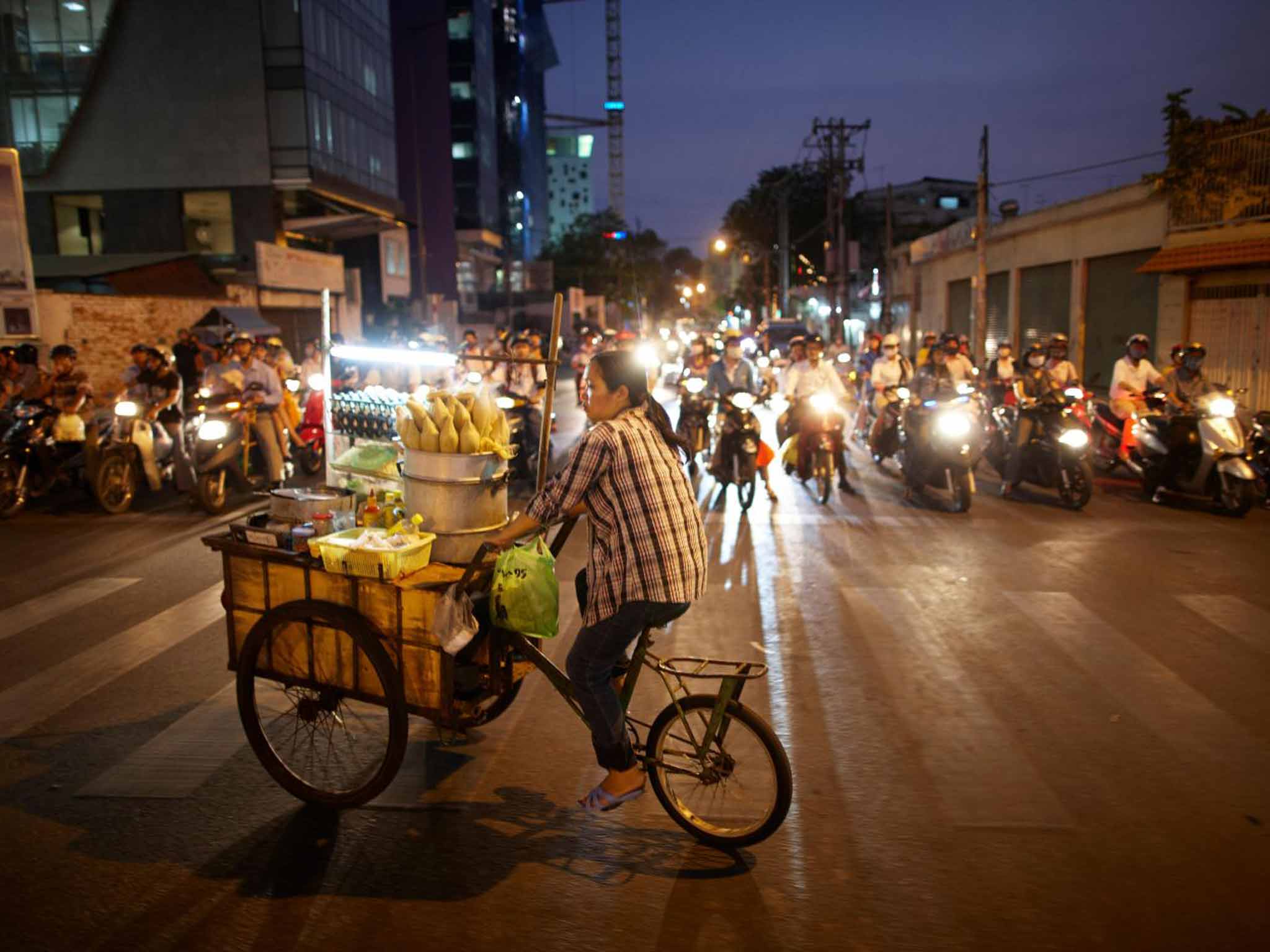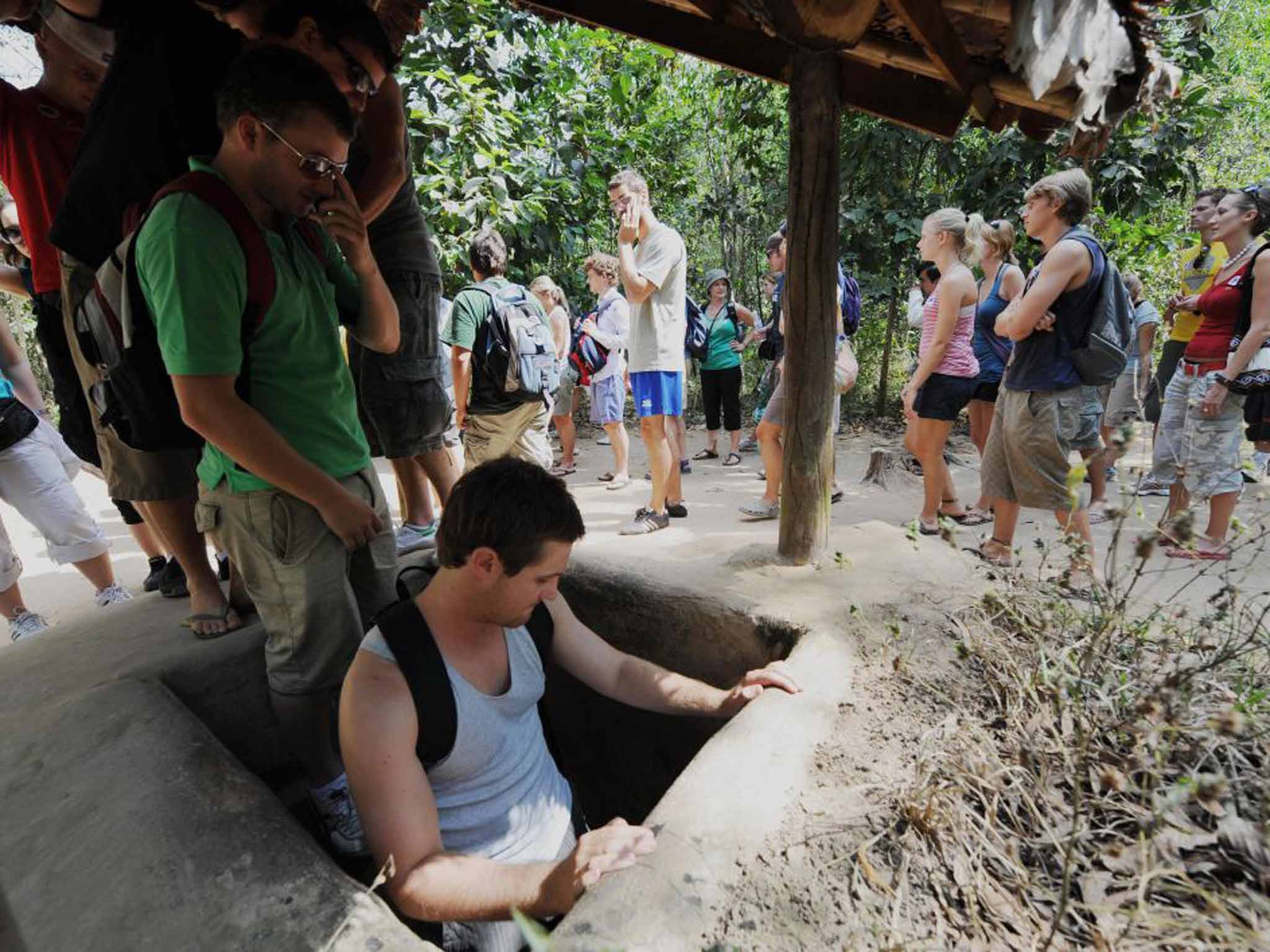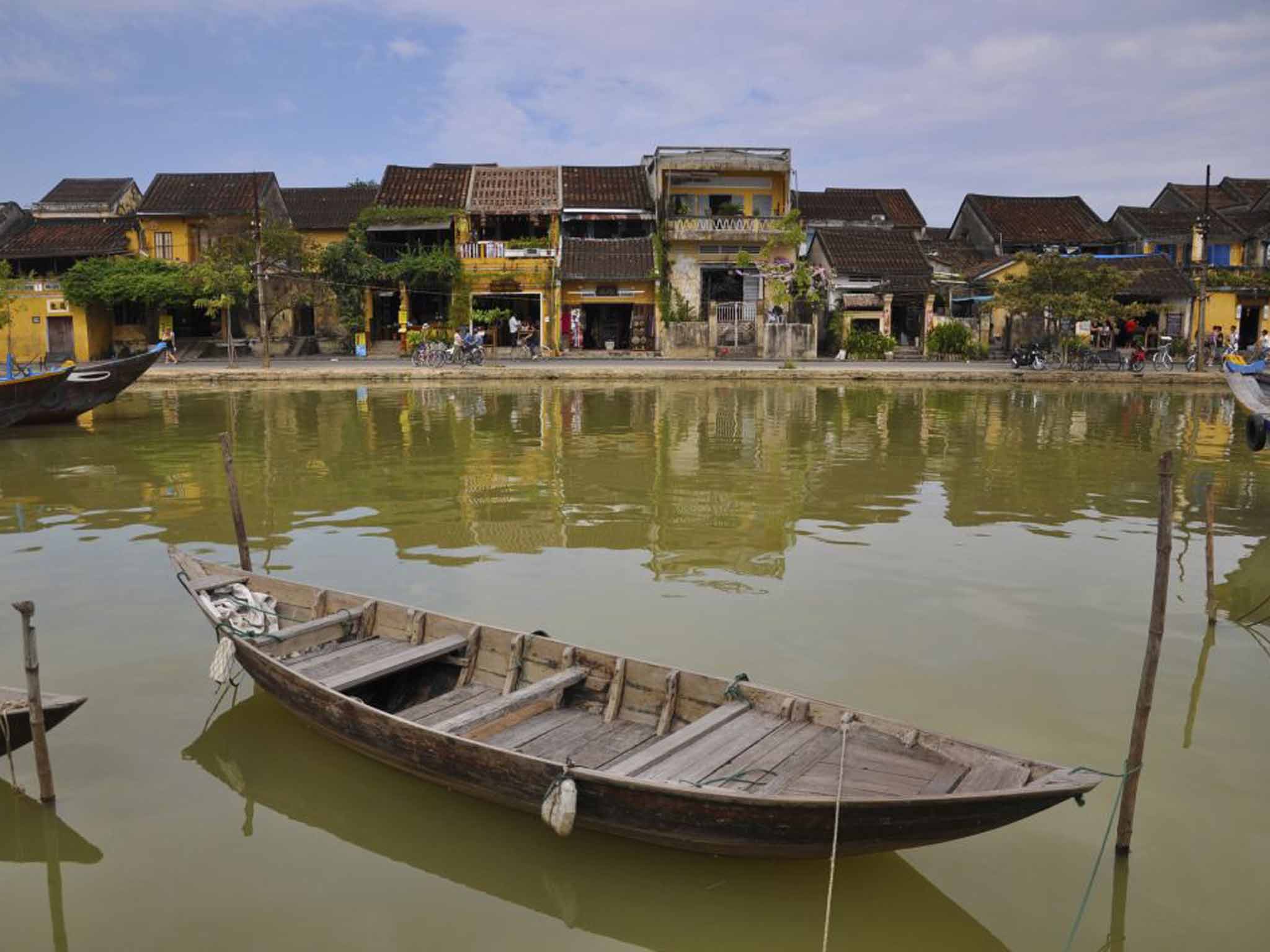The Independent's journalism is supported by our readers. When you purchase through links on our site, we may earn commission.
Vietnam after the war: Visiting 40 years after the Fall of Saigon
Life marches on, says Chris Leadbeater, but a division is still tangible

Your support helps us to tell the story
From reproductive rights to climate change to Big Tech, The Independent is on the ground when the story is developing. Whether it's investigating the financials of Elon Musk's pro-Trump PAC or producing our latest documentary, 'The A Word', which shines a light on the American women fighting for reproductive rights, we know how important it is to parse out the facts from the messaging.
At such a critical moment in US history, we need reporters on the ground. Your donation allows us to keep sending journalists to speak to both sides of the story.
The Independent is trusted by Americans across the entire political spectrum. And unlike many other quality news outlets, we choose not to lock Americans out of our reporting and analysis with paywalls. We believe quality journalism should be available to everyone, paid for by those who can afford it.
Your support makes all the difference.There is no frantic buzz of helicopter rotor blades above 22 Ly Tu Trong Street today, no lengthy queue of frightened people, and definitely no hint of eras coming to violent ends.
Standing a few doors down from this unremarkable apartment block – so that I am able to see its upper floors – I am struggling to picture it as the location of one of the 20th century's most dramatic moments. But its roof is unmistakably the one captured in that famous image taken by Dutch photographer Hubert van Es on 29 April 1975 – when the address was 22 Gia Long Street in Saigon, the building was the headquarters of the United States Agency for International Development, and an American "Huey" chopper was perched on its top deck, preparing to whisk US government employees and fearful citizens of South Vietnam to safety on the desperate life raft of Operation Frequent Wind.
A day later, North Vietnamese troops would burst into a metropolis that would rapidly be renamed Ho Chi Minh City – and one of the most controversial events in American history would be over.
Forty years have now passed since these events unfolded – and as I stroll back to the wide avenue of Dong Khoi, it feels like it. That urgent swell of engine noise and bodies is still wholly present, but now it is not military men making a commotion. It is the swarm of motorcycles, and their passengers, as Vietnam's biggest urban enclave goes about its business. Was there a conflict here – a seismic struggle of skewed ideology, inhumanity and up to (if you use the highest estimates) four million deaths? On this bright day, in a city which has embraced the 21st century, it seems a faded nightmare.

The basic facts of the Vietnam War need only scant retelling – the partition of this proud South-east Asian country into two in the wake of the Second World War (officially at the Geneva Conference of 1954), the communist North glowering at the American-backed South; an outbreak of hostilities that history has pinned to November 1955; Washington DC's belief that the whole region might fall to the far left, and its growing involvement in a fight against Viet Cong guerilla insurgents.
Despite the four-decade gap, it is not tricky to find echoes of the conflict in the city where its endgame was played out. Its final seconds are forever enshrined in the Independence Palace, where two North Vietnamese tanks smashed through the gates of what was the seat of South Vietnamese presidential power at 10.45am on 30 April 1975 – and brought the war to a close. Wandering through the rooms of an unlovely concrete structure which was only completed in 1966, I am half convinced that the clock stopped at that minute – the Seventies living on in a map room which reeks of the Cold War in its rows of dead dial telephones and charts of a divided planet, and a gambling den which, all gaudy sofas and cocktail bar, could be the space where a Moore-era Bond villain goes to de-stress.
The nearby War Remnants Museum at least provides a suitable note of solemnity. True, this recollection of 20 dreadful years is somewhat one-eyed, a cluster of US hardware – helicopters, jets, tanks – arranged outside as trophies. But the brutality of what occurred here – on both sides of the line – is unavoidable. It bleeds from the walls in a bleak series of photographs where the darkness is all-encompassing: AP lensman Nick Ut's eternal shot of nine-year-old Kim Phuc running naked towards the camera, her body drenched in napalm; an American GI performing unsuccessful mouth-to-mouth on a fallen colleague.
And yet, elsewhere, the horror has receded. At the Cu Chi Tunnels, a nest of Viet Cong resistance, 20 miles north-west of the city, I am able to crawl through a subterranean labyrinth which has been widened to permit access to the very Americans it once guarded against – albeit now as tourists. Adjacent, there is a firing range where you can let loose with relevant weaponry, AK47s and M16s. The roar reverberates across what is still farmland, and leaves me uncomfortable – a shriek of destruction trivialised at £1 a bullet.
The gloom has been commercialised, too, back in the city at the Rex Hotel, where war reporters used to drink as they filed their missives, their mocking term for the briefings they received here from US officials – "Five O'Clock Follies" – now scrawled in neon above the rooftop garden bar. Sitting here with a 200,000 dong (£6) cocktail, it dawns on me that Ho Chi Minh City – or Saigon, as most locals still call it – has all but put aside the war, and certainly does not see itself as a conquered entity.
From the bar, my gaze is drawn to two landmarks, and two other narratives. On one side, the red-brick steeples of the Notre Dame Basilica – twin reminders that, before other foreign powers had designs on it, Vietnam came under the rule of 19th-century France. On the other, the silvery curves of the Bitexco Financial Tower, a helipad jutting from its body – a sleek vision which could have migrated from Dubai. I can still see the latter when I take a chair at Pho 24, a popular noodle cafe on Dong Khoi, and watch a group of teenagers as they go through their rituals, giggling selfies and smartphone chatter, 2015 alive and well.
And yet, in a way, Vietnam still seems divided. It was doi moi – the country's 1986 move towards a market economy, its equivalent of perestroika – which gave Ho Chi Minh City its liberated vibe. But 1,000 miles north in Hanoi – the one-time capital of North Vietnam, now the national capital – 1975 still loiters in sight.
Ho Chi Min, the old warhorse, still holds prime position here, staring at the world from his mausoleum on Ba Dinh Square, a red glow emanating from within at night. And maybe it is the narrowness of its alleyways, but Hanoi seems to have shrunk where Saigon has grown. Its old quarter is a chaotic warren of shops stacked with foodstuffs and spices – or, in the case of Old Propaganda Posters on Dinh Liet, colourful fragments of cliché, the swarthy agricultural worker, the loyal soldier. Its French quarter, meanwhile, still dreams of Gallic empires, St Joseph's Cathedral singing of 1886 and Notre Dame de Paris in its grand Gothic Revival façade. When I sit down at the adjacent Marilyn Cafe – all long metal balcony and hints of New Orleans, 2015 seems to have escaped from view.

But then, in a war that was so divisive, it is perhaps not surprising that scars of division remain – although it takes me a 450-mile flight south to find the most obvious. Pitched roughly halfway up the Vietnamese torso, Hue was almost on the frontline – located a precarious 60 miles below the notorious Demilitarised Zone which separated the two enemies. Half a century on, day tours take visitors into what was a gateway to hell, while keeping them strictly to trails beyond which thousands of unexploded devices lurk.
Hue also wears its wounds. Before France, before America, before the bombs, it was the capital of Vietnam's Nguyen dynasty – emperor-kings who ruled from the city's grandiose Citadel. Their 19th-century pomp is still clear in its ornate courtyards, but is smudged too by the bullet holes which pockmark the exterior walls, souvenirs of the Tet Offensive, the North's notorious viper strike on the South which saw Hue occupied in January 1968.
My guide, Hoang Trong Nhan, was five in 1975 – old enough to recall fleeing Hue as the North advanced, and seeing bodies littering the roadside. Today, though, he is preaching goodwill. "The Vietnamese dragon is humble, peaceful," he says, pointing to a sculpture outside the Citadel's Forbidden Purple City. It is a soft-eyed beast, its jaws closed, in contrast to the snarling Chinese example next to it. "We are," he says, "a nation of farmers, born in the rice fields – wherever you come from."
We drive south, following the path he and his family took 40 years ago, along the edge of the South China Sea. Seventy miles beyond, the close-knit pairing of Hoi An and Da Nang could be an encapsulation of Vietnam's last half-millennium. The former sprouted in the 16th century on the estuary of the Thu Bon river, a trade hotspot that drew in Chinese and Japanese merchants. It still recalls this epoch in its covered bridges and quiet shrines – a time capsule unaffected by the war. The same, though, cannot be said of My Son. A 25-mile drive south-west takes me to this jungle-shrouded pocket – a cluster of Hindu temples built by the Cham people between the fourth and 14th centuries. They must have been magnificent in their day, but carpet-bombing of the site by US planes reduced many of them to dust.
America's ghost still haunts Da Nang. The city, home to one of the biggest US air bases, was a good-time zone, awash with soldiers unwinding on what they called "China Beach". In some senses, little is different, though now, relaxation is the preserve of guests at the five-star resorts that increasingly dot the shoreline. Here is the modern Vietnam, stepping out of the shadow of the past. "As a country, we are 70 per cent Buddhist," Hoang says as he leaves me at the city's flash new airport. "We are taught tolerance, forgiveness. And we look at tomorrow – not yesterday."
Getting there
Vietnam Airlines (020 3263 2062; vietnamairlines.com) flies to both Hanoi and Ho Chi Minh City direct from Heathrow. Wendy Wu Tours (0844 288 5396; wendywutours.co.uk) offers a 12-day Vietnam At A Glance private tour, which visits Hanoi, Hue, Hoi An and Ho Chi Minh City from £2,690pp including flights.
Visiting there
Independence Palace, Ho Chi Minh (00 84 8 85 094; dinhdoclap.gov.vn).
War Remnants Museum, Ho Chi Minh City (00 84 8 3930 5587; warremnantsmuseum.com).
Staying there
Hanoi Daewoo Hotel, Hanoi (00 84 4 3831 5000; daewoohotel.com). Doubles start at US$80 (£53), room only.
Hotel Saigon Morin, Hue (00 84 5 4384 6410; morinhotel.com.vn). Doubles from VND1,636,364 (£51), with breakfast.
The Nam Hai, Hoi An (00 84 51 0394 0000; ghmhotels.com). Villas from US$570 (£381), room only.
Rex Hotel, Ho Chi Minh City (00 84 8 3829 2185; rexhotelvietnam.com). Doubles from US$123 (£82), including breakfast.
More information
British passport-holders require a visa which costs £44 (020 7937 1912; vietnamembassy.org.uk).
Click here to view Asian tours and holidays, with Independent Holidays.
Join our commenting forum
Join thought-provoking conversations, follow other Independent readers and see their replies
Comments